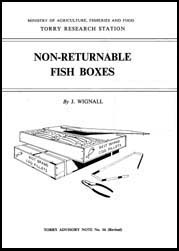Contents Index

Accompanying Notes
Table of Contents
By J. WIGNALL
MINISTRY OF AGRICULTURE, FISHERIES AND FOOD
TORRY RESEARCH STATION
TORRY ADVISORY NOTE No. 16 (Revised)
Crown copyright material is reproduced with the permission of the Controller of Her Majesty's Stationery Office.
This electronic document has been scanned using optical character recognition (OCR) software and careful manual recorrection. Even if the quality of digitalisation is high, the FAO declines all responsibility for any discrepancies that may exist between the present document and its original printed version.
Explains the properties required of a non-returnable box for the inland transport of wet or smoked fish. Discusses the merits of three main types of box, wood, fibreboard and expanded polystyrene, with regard to mechanical strength, insulation, appearance and hygiene, weight, disposal and cost. Wood is no longer used because it does not meet hygiene requirements and expanded polystyrene has become primarily the material of choice. The increase in air-freight traffic has meant that additional factors have had to be taken into account in box design such as increased mechanical strength and containment of melt water to conform to the standards required for air-cargo.
(FAO in partnership with Support unit for International Fisheries and Aquatic Research, SIFAR, 2001).
Introduction
What is required of a non-returnable box?
Why use a non-returnable box?
Types of non-returnable box
The types compared
Which box is best?
Contents Index